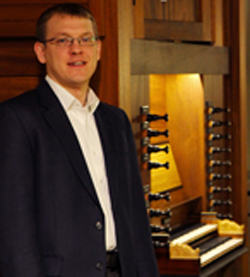by Daniel Hathaway

After an overture-like piece by George Muffat, Moyer’s program began in Advent and concluded with Pentecost, visiting the festivals of Christmas, Epiphany and Easter and the penitential season of Lent (and Holy Week) along the way, featuring settings of seasonal hymns by Nicolaus Bruhns, Dieterich Buxtehude, Heinrich Scheidemann and Johann Sebastian Bach, as well as a bucolic Noël by Jean-François Dandrieu and plainchant elaborations by three generations of Spanish composers — Juan Bermudo, Sebastian Aguilera de Heredia and Juan Cabanilles. Bach’s “Great” d-minor toccata and fugue finished the year with a postlude-like flourish.
The Church of the Covenant now owns two vastly different organs. A very large, originally E.M. Skinner instrument from 1930, rebuilt by Aeolian-Skinner in 1958-59 and enlarged by Holtkamp in 1996, lives in chambers on either side of the chancel (some pipes peek out from the organ cases). The new instrument stands proudly out in the open in the reconfigured rear gallery, where nothing impedes the direct flow of its sound into the nave. Unlike its older sister, the Newberry Organ comprises a mere fifteen sets of pipes. Small but mighty, at full throttle it fills the church with powerful sound but its individual voices are distinct and each full of character. Moyer skillfully chose registrations that showed the range of color the instrument can produce and suited them perfectly to the music at hand.
Unlike pianists who can subtly control the way hammers touch strings, organists are people who open and close valves that let air into pipes. The artistry is all about how you do that. In Muffat’s Toccata Quinta (from the scary-sounding collection Apparatus musico organisticus), Moyer set up the kind of “open” articulation between notes that lets the pipes speak clearly and gives life and vibrancy to the music. His runs were thrilling and his sense of pace made the piece sound suitably rhetorical — like a well-written and cleverly-delivered speech.
At the other end of the program, Moyer’s reading of a similarly-structured work, Bach’s famous toccata and fugue, made a ubiquitous piece sound newly-minted. Fine shaping of musical gestures, masterfully-timed pauses and clever elaborations of ornaments and chord voicing breathed new life into an old chestnut.
Moyer’s stop choices delineated the musical differences in the four verses of Bruhns’s Nun komm, der Heiden Heiland chorale fantasy and demonstrated that the organ’s voices can stand up well to one another (in verse 4, the trommet and dulcian proved to be equal partners). The organist found charming, folksy combinations for Dandrieu’s Bon Joseph écoutez moi which played effectively with the organ’s meantone tuning, and made (with the help of a registrant) perfect rhythmic connections between verses.
Buxtehude’s Wie schön leuchtet der Morgenstern again showed Moyer’s expertise with the articulation of Baroque musical gestures, just as Scheidemann’s three-verses of Christ lag in Todesbanden again demonstrated his keen ear for color. Spanish settings of Pange lingua provided a mid-program change of pace and sonority. Bach’s canonic setting of Dies sind die heil’gen zehn Gebot and the long setting of Komm, Heiliger Geist with the chorale in the soprano were elegantly and flawlessly played. Liberal use of the whole organ tremulant humanized the air stream in a number of pieces.
It’s delightful to hear an organ recital where everything seems so right and the playing so much in the service of the instrument and the repertoire. Too bad that June 10 was the first warm Sunday afternoon in a while: only a small audience turned out, but they were in for a treat.
Published on ClevelandClassical.com June 11, 2013
Click here for a printable version of this article.



